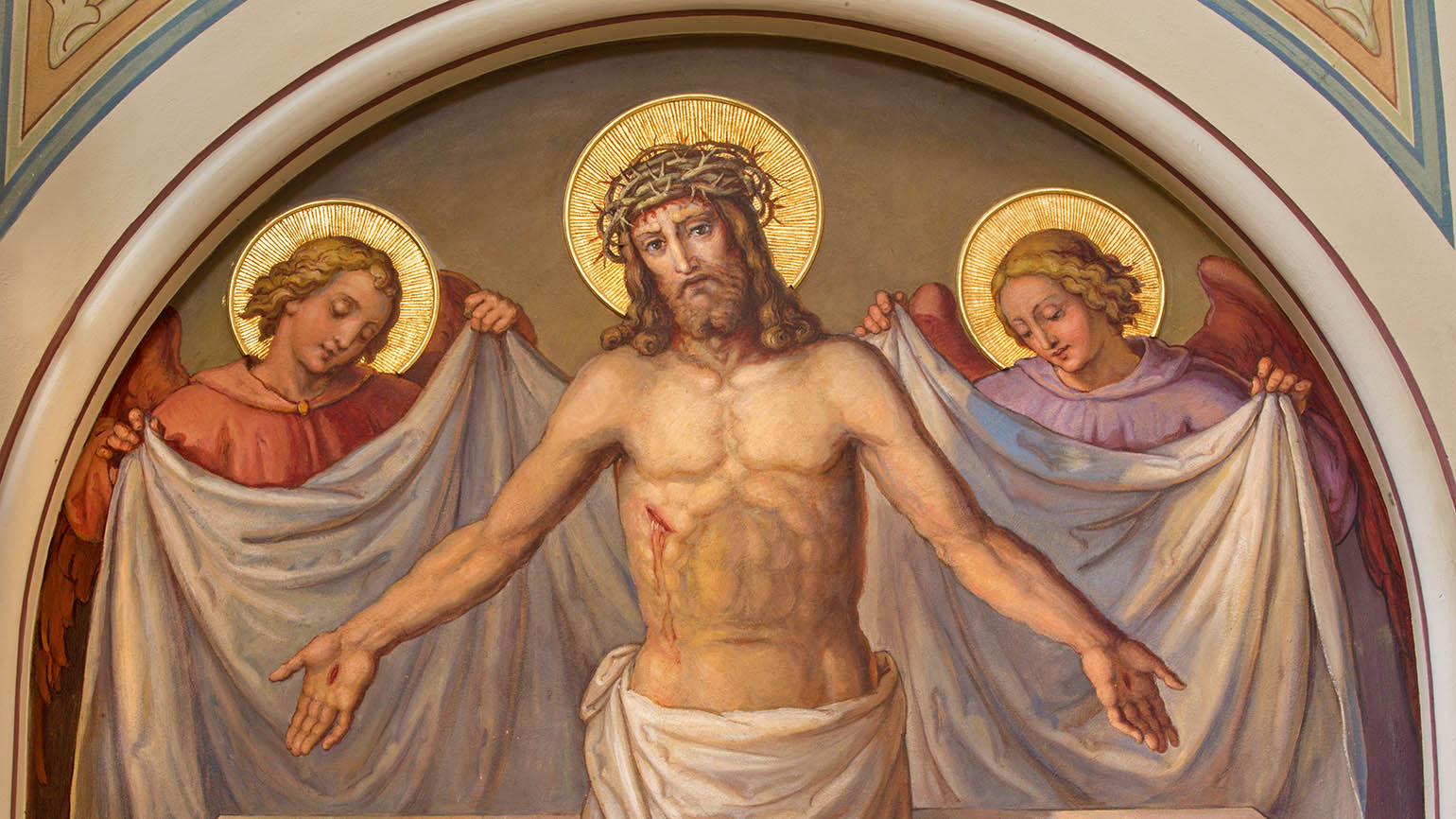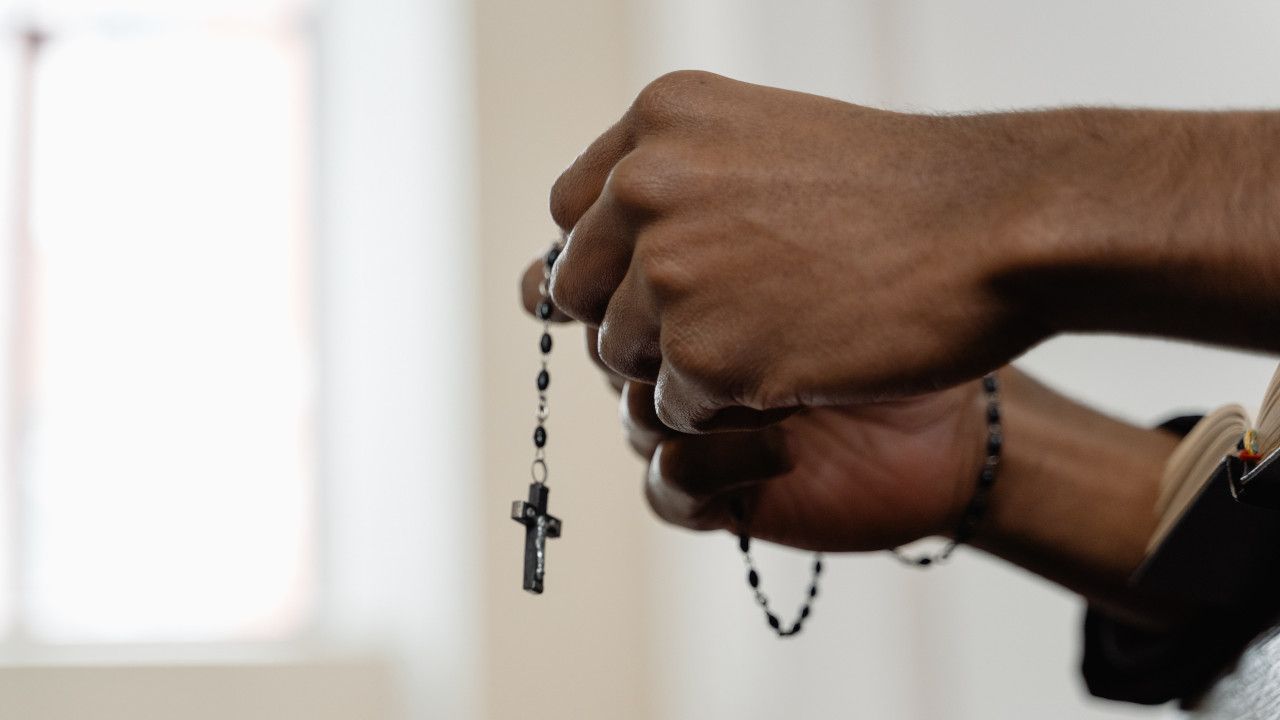Dear Souls and Hearts Members,
I am so pleased to share with you the first in a series of six weekly reflections by Marriage and Family Therapist Gerry Crete, Ph.D, our own Dr. Gerry, co-founder of Souls and Hearts and a dear friend.
A bit of backstory – I first met Dr. Gerry in April 2016 at the Catholic Psychotherapy Association annual meeting in Austin, Texas, where he presented with Jennifer Madere on the intersection of faith and trauma. His description of practicing EMDR (Eye Movement Desensitization and Reprocessing) grounded in a Catholic understanding of the human person impressed me, as did his original thought and evocative questions.
Dr. Gerry’s presentation launched me on a journey to get my own EMDR basic and then advanced training, which in turn led me to Sandra Paulsen’s work on using EMDR with parts, which then led me to search for the best models of multiplicity inside, which brought me to Internal Family Systems, which informs much of our work at Souls and Hearts.
Thus, I have a deep sense of gratitude to Gerry who initially inspired me toward better, deeper, and more nuanced psychotherapy for my clients with complex trauma.
Over the following five weeks, I will share with you a bit about how our relationship developed as I introduce his weekly reflections.
I am so glad Gerry’s basso profundo voice is sounding in these virtual pages, sharing with us his fresh insights and creative syntheses. Thank you, dear Gerry, for continuing to share your work with us. Without further ado — here is Dr. Gerry.
Reconciling Internal Family Systems with our Catholic Christian Faith
by Gerry Crete, Ph.D.
Initial Journey
Treating trauma and addictions has been my focus as a Catholic Christian professional counselor and marriage and family therapist. My early training in EMDR and success with this modality led to my role as a consultant for EMDR clinicians. A powerful approach for treating trauma, EMDR incorporates the body, the emotions, and the limbic system, as well as the cognitive functions of the mind.
Through all of my EMDR training, an overarching idea emerged that each person has an inner world and that the whole person was made up of many subpersonalities. My trainer Deb Kennard helped me understand how our clients have overdeveloped and underdeveloped aspects of personalities, from the work of Ron Kurz’ adaptive “characters” (invisible one, independent one, chameleon, life of the party, etc.).
I learned about “resources” such as Laurel Parnell’s nurturing and protector figures. I also discovered that as an EMDR practitioner, I could lead and direct my clients’ inner resources, such as their faith, to bring about greater levels of healing.
Other approaches including the empty chair technique from Gestalt therapy and inner child work from Charles Whitfield were also found to be powerful and transformative in working with my clients.
Further training by Wendy Lemke in Ego State Therapy (EST) and by Sandra Paulsen in the integration of EMDR and EST influenced by practice, as did training in Clinical Hypnosis by the American Society of Clinical Hypnosis and the Milton Erickson Foundation. As I incorporated these complementary methods, I saw a real positive change in my work with clients.

All of this training and practical experience with EMDR and the other complementary modalities laid the groundwork for my introduction to Richard Schwartz and Internal Family Systems (IFS). Schwartz’s books, videos, conferences, as well as Stepping Stones training, and consultations were instrumental in both my own growth and in my ability to better serve my clients. I also found an IFS trained therapist who was able to help me work through some of my own past trauma.
When I began incorporating “parts work” into sessions with my clients, my therapeutic work was elevated to the next level. It wasn’t uncommon for a new client to tell me that they had received more benefit from two or three sessions of parts work with me than they had in years with other forms of therapy.
Parts work enhanced my use of EMDR to treat trauma and my use of Emotionally Focused Couples Therapy (EFT) to help couples.
Like most modern therapies, parts work emerged from a variety of influences such as Jungian psychodynamic, Gestalt, family systems, transactional analysis, and clinical hypnosis.
Parts work first emerged as a fully formed methodology as Ego State Therapy (EST) developed by John and Helen Watkins in the 1970’s. In the 1980’s Richard Schwartz developed Internal Family Systems (IFS) which is user friendly for client and clinician alike and has made significant contributions to the practice of parts work.
One major contribution of IFS is the identification of certain roles that parts play such as the managers, firefighters, and exiles. IFS also developed the important concepts of unblending and unburdening. Unblending refers to the process where the “Self” gains some distance from each of the parts. Unburdening refers to the process of helping each part let go of the negative beliefs he or she is carrying.
I have learned and benefited from both IFS and EST and the bottom line for me clinically is that these therapies work. My clients report positive outcomes, and they can use the tools learned in session in their everyday life for healthier functioning and leading a more fulfilling life.
Philosophical and Theological Challenges
Recognizing the effectiveness of parts work, I also had several important philosophical, theological, and anthropological questions that needed answers in order to reconcile this method with my commitment to living and working as an authentically Catholic Christian.
My specific questions included:
How does the “Self” relate to the human soul?
Is the idea of “parts” Biblical and in accord with Church teaching?
Where does sin fit in?
How does salvation work in this system?
The founder of Internal Family Systems, Richard Schwartz, in his book No Bad Parts equates the “Self” with both the soul and with God (a term which he doesn’t often use, instead he says “SELF”). I knew this was not correct as it borders on pantheism.
Other problematic philosophical issues for me around the emergence of EST from the psychodynamic tradition (think Sigmund Freud, Carl Jung, and Alfred Adler), and around the use of clinical hypnosis, as well as the Watkins’ model in working with DID (Dissociative Identity Disorder, formerly Multiple Personality Disorder) propelled me on a path of discovery.

I began exploring the Christian concept of “self” especially as it relates to multiplicity. I attended a workshop by Orthodox Christian Julie Honeycutt where she discussed integrating Christianity with IFS. I read many articles and joined a Facebook group where clinicians discussed the topic of Christian integration. I participated in discussions with members of Souls and Hearts’ Interior Therapist Community (ITC) which seeks to integrate IFS and the Catholic faith. I found a great deal of useful perspectives in all these pursuits.
I uncovered biblical ‘proof texts’ and approaches, including St. Paul’s description of the Church, the body of Christ, as having a variety of parts that must work together in harmony.
Yet I still sought answers at a deeper level to more difficult philosophical questions about the mind, the body, the heart, the soul, sin, and redemption and how they related to parts work.
This seeking fueled by my desire for answers to the deeper questions led to my embarking upon a larger project and I began writing a book to answer Catholic questions about parts work.
I aim to show that parts work is written into the very fabric of the Judeo-Christian story and central message. It has a place most notably within the fall-redemption paradigm that perhaps some postmodern spiritual traditions would condemn or dismiss. I will argue that the fall-redemption paradigm is at the very core of the Christian message and resonates with the experience of all humankind. Parts work has an important and central place within the story of humankind’s fall and redemption.
In contrast to my assertions, some IFS authors present ideas which are simply problematic from a Catholic Christian perspective.
For example, in their book, Many Minds, One Self, Richard Schwartz and Robert Falconer lay out a kind of biological and evolutionary development for the concept of multiplicity of the self. They explore how the idea of multiplicity was at times accepted and other times rejected. They emphasize that in the more eastern and esoteric traditions such as Shamanism, Hinduism, Taoism, Buddhism, Kabbalah, and Gnostic Christianity there is an acceptance of multiplicity whereas in the more traditional Western religions such as Islam, Judaism, and Western Christianity there is, with few exceptions, a rejection of multiplicity. I find this to be a rather gross simplification.
Schwartz and Falconer imply that the fall/redemption paradigm which is the root of both Judaism and Christianity is a false or at least unhelpful narrative. There is a wholesale rejection of the concept of sin and a naïve underestimation of the power of evil. This is not to say that Christianity has not been guilty of various excesses such as found in Jansenism’s focus on sin and hellfire or Calvinism’s emphasis on total depravity. But the overwhelming message of Christianity is one of hope based in love.
Schwartz even takes aim against St. Augustine and the doctrine of original sin. Original sin is an important doctrine for good reason; however, the doctrine of original sin cannot overshadow the victory of the cross or St. Augustine’s doctrine of grace.
I continue to study the bigger picture of Christianity and its spiritual richness as it relates to parts work. I hope to draw from the wealth of tradition and from my personal prayer and discovery.

A Truly Catholic Approach
My familiarity with many Carmelite writers such as St. John of the Cross, St. Teresa of Avila, St. Elizabeth of the Trinity, and St. Thérèse of Lisieux had long informed my spirituality. With this desire to connect Catholic thought with parts work, I mused about how St. Teresa’s Interior Castle described the soul as having many mansions and how this corresponded to the interior world. I discovered several books by Benedictine writers such as Fr. Michael Casey and Fr. Boniface Hicks that inspired me to explore the topics of humility, obedience, and silence – not themes typically found in Ego State Therapy or Internal Family Systems writings, yet central to Catholic spirituality and well-being.
Humility became a clear beacon – a key to integrating Catholic faith and parts work.
I explored the writings of St. John Cassian and the Rule of St. Benedict for insights about humility. Delving into this topic, I discovered a treasury of Catholic thought in the writings of Dietrich von Hildebrand and began a reading spree.
A phenomenologist rather than a Thomist, von Hildebrand fascinated me. In von Hildebrand I discovered the most comprehensive modern exploration of Catholic concepts such as simplicity, continuity, consciousness, moral beauty of the soul, self-knowledge, contrition and of course humility. Interestingly, his philosophical approach influenced St. Pope John Paul II’s personalism.
Bridging the Gap
In time it became clear to me that the missing pieces in the secular parts work approaches had to do with a proper understanding of the nature of being human in relationship with God.
Our Christian understanding of God as the ultimate reality, the absolute, the Creator of the universe, and completely “other.” We are completely dependent on Him. And yet, this omnipotent God created us in His image, sees us, knows us, and delights in us. He is a personal God, and He raises each one of us to an unfathomable dignity.
For the Catholic Christian there is an interesting paradox. On one hand we are weak creatures in need of redemption and daily sanctification – on the other hand we are beloved children of God destined to join Him in glory and to be united to Him sacramentally.
Our humility stems from being both dependent on God and powerfully and beautifully loved by Him as well. God is a personal God, and He connects with us individually as persons, a radically different perspective from the mix of pantheism, Buddhism, and atheism that you find in the approach of Richard Schwartz. Don’t get me wrong, Schwartz is a brilliant thinker and a gifted therapist. His model, Internal Family Systems, is powerful, effective, and in many ways more accessible than Ego State Therapy. I have deep respect for the work he has done in popularizing parts work, but it is not Christian and based on his expressed beliefs it seems he lacks an understanding of the essence of Christianity, especially the rich biblical and Catholic tradition.

The Luminous Mysteries
My counseling practice is named in honor of the Transfiguration, the moment when Jesus first fully reveals His divine nature – the moment of truth (Matthew 17:1-8). I have several icons of the Transfiguration as this biblical event holds deep spiritual meaning for me. The icons depict five figures present at this encounter: a radiant Jesus in the center, Moses and Elijah in glory on either side of Him, with Peter, James, and John below, writhing in fear and confusion.
As I was praying with one of these icons and reflecting on the Transfiguration, a powerful insight hit me as I recognized an image of the self-system in it. Jesus represented the fully regenerated inmost self, Moses and Elijah were unburdened parts, and Peter, James and John were parts still carrying burdens.
With this revelation, came a sort of illumination with regard to other iconic representations of pivotal moments in Christ’s life and their connection to ‘parts mapping.’ In His Sermon on the Mount, Jesus’ Beatitudes identified all sorts of parts such as the peacemakers, the poor in spirit, those who weep and so on. At His Last Supper, Jesus – the inmost self – shared with the parts in communion… in communion… the self in communion.
An Epiphany
It suddenly became clear to me that the goal of a Catholic Christian approach to parts work was that all the parts were in communion with the inmost self, and in communion with a God who loves them. My great internal excitement with this discovery gave rise to a deep desire to capture, share, and foster these ideas with hopes that it could be form the foundation of a radical and deep philosophy of parts work for Christians, one that is fundamentally in line with a sacramental and incarnational theology and at the same time therapeutically effective and life changing.
This approach offers a way to bring real healing at a deep level by using the truth of a proven secular science baptized and infused with the richness of Christian spiritual truth. Not a mere christening, this discovery shows that deep within the context of the Christian tradition the truth of the inmost self and the parts of the self-system are present and visible.
Mysterious Illumination
As I explored the truth about parts in the Transfiguration, the Last Supper, and the Beatitudes, it hit me that Pope St. John Paul II’s late 20th century additions to the traditional Catholic Rosary prayers, the Luminous Mysteries of the Rosary, held a key.
The Luminous Mysteries represent a focus on the ministry of Jesus and as such provide a rich meditation that reflects on the meaning of His actions and a rich symbolism that reveals deeper truths about His identity and His purpose. As I reflected on the Luminous Mysteries, I realized they also provided valuable insights into our self-worth, our parts, and the way our parts interact with the inmost self and with God.
There is a rich tradition of biblical interpretation best expressed in the early church in Alexandria which interpreted the Bible using typology. In this type of study, the Bible reveals deep truths through symbolism, metaphor, and allegory. This type of study allows for a multi-dimensional exploration of metaphysical realities. Christ, as both human and divine, is the bridge between God and humanity. He is the bridge between God and our inmost self.
In the actions of Jesus, we find a type of the inmost self. In His actions, Jesus walks us through the journey of the inmost self. As we imitate Jesus in our lives, we honor and empathize with our parts, we help them unburden their sins, and we heal our exiles. We do all this so that we can be agents of healing and transformation in the world at large.
My prayer is that this series, my soon to be published book with Sophia Institute Press (coming in November, God willing), Dr. Peter’s podcast Interior Integration for Catholics, and all the work of our online outreach Souls and Hearts become a guide for both clinician and client alike in understanding one’s parts in an authentic and rich Catholic tradition.
In the following weeks I will be writing about a Christian parts work approach as I explore each of the five Luminous Mysteries of the Rosary.
Be With the Word for Pentecost
Thank you, Dr. Gerry, for this reflection. And, please join Dr. Gerry and me for a 47-minute discussion on ending power struggles in important relationships in this week’s episode for Pentecost Sunday. Dr. Gerry and I read the Mass readings for Pentecost aloud here.
Resilient Catholics Community
The RCC may be a great fit for you if you are a Catholic adult who embraces the Faith, and for whom these ideas of parts, multiplicity and unity inside, and interior integration resonate. If you can engage with the experiential exercises in the Interior Integration for Catholics podcast, if you want to connect with other Catholics on a pilgrimage to much better human formation, consider joining us. I’ve put together a 19-minute experiential exercise to help you discern whether to apply to the RCC and here is a link to our informational video about the RCC.
I invite you to bear in mind that applying to the RCC is just a first step in a weeks-long discernment process of joining the RCC. Along the way, you will take the PartsFinder Pro (PFP) and from that receive your PFP sheet detailing our ideas about your parts and how they relate inside you. You can download a PDF for a sample fictional report for a man and a woman to see what those look like. The women applicants will get a 15-minute interview with our Lead Navigator, Marion Moreland, to review their PFP reports and to go over any questions about whether the RCC is a good fit for you; I will personally contact the male applicants.
Warm regards in Christ and His Mother,
Dr. Peter
P.S. Please keep sharing these weekly reflections with those who might benefit!
